Your Pattern = Your Productivity
The simple set of advanced plate surface patterns in the KODAK FLEXCEL NX System have been developed through complex engineering to optimize print performance for whatever print setup you’re running and anilox you’re using.
One simple test matches your print setup to the correct advanced plate surface pattern in the KODAK FLEXCEL NX System, delivering unrivalled ink laydown and color control for consistent, repeatable print on multiple runs. Steve Smith takes a closer look at the test and shares the productivity gains three companies delivered…
From the introduction of our first plate surface pattern in 2010, we’ve developed a set of advanced multi-functional plate surface patterns that optimize print for whatever setup you’re running – process, spot colors, whites or varnishes – and the matching anilox you’re using.
The results of finding your pattern are transformative, ultimately cutting make-ready, reducing ink consumption, minimizing waste and boosting your productivity.
How does it work?
We align your print conditions to the correct patterns with a simple test. We take the anilox you’re using and run a single-color print on a plate with all of the patterns across it; including linear step-wedges with a variety of screen rulings – then analyze the print result. The impacts the patterns have are clear to see.
“On a white ink print test, a wide web customer reduced the ink used by 20% on a flexible substrate compared to other plates.”
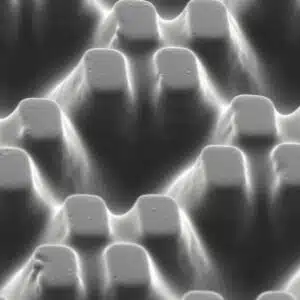
Magnified Advanced Plate Surface Pattern utilized to achieve optimal density and smoothness of the ink laydown.
In the test, we’re measuring the density and smoothness of the ink laydown – the pattern that’s right is generally the one scoring highest on density. It’s what we call optimized print: if there’s too much ink transfer, we can see air bubbles on the print and if there’s not enough ink laydown it looks like the image has been starved of ink.
That ideal, optimal balance is where the ink is just filling the pattern near to the top of the plate surface, giving the smoothest, thinnest laydown. This is being controlled by the advanced plate surface pattern. When the plate is compressed during printing the ink volume fills the pattern to transfer the ink, without excess ink applied.
This optimized use of ink means densities can be achieved without reaching for expensive high pigmented ink, at the same time reducing the ink film weight. On a white ink print test, a wide web customer reduced the ink used by 20% on a flexible substrate compared to other plates.
Another wide web customer – surface printing on opaque white PE – achieved 15% ink savings with an optimized advanced pattern plate compared to a competitors’ plate they had been asked to use. In both cases, this was without changing the anilox that was in use.
The patterns
Apple founder Steve Jobs once said that one of the hardest jobs is to make things simple. There’s often a lot of complexity behind a simple interface or user experience.
Our approach to plate patterning is similar. Behind the small range of patterns is complicated, robust engineering at a micro level.
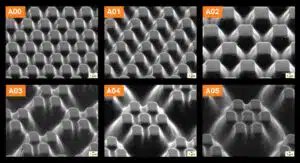
Advanced KODAK DIGICAP NX Patterning: A range of patterns – expertly engineered to optimize ink transfer for the widest range of print conditions.
At its core, each pattern is a 5×10 micron rectangle that can be manipulated and controlled. This is a very fine level of engineering when you think a human is about 70 microns wide.
We’ve tested hundreds of combinations to establish the smallest set and best range of pattens to cover process colors, spot colors and whites. The simplicity comes from only needing this range of six core patterns with two multi-functional edges.
Features of the patterns include Advanced Edge Definition around every dot shape and object (including text) that improves ink laydown with existing aniloxes. Then there is the channels in the micro surfaces of the PureFlexo™ Printing patterns that work to reduce unwanted ink spread, giving less gain on press.

Advanced Edge Definition takes edge control to a new micro level.
The accuracy and control the pattern gives helps control ink flow and creates the same results on a commercial press, day in day out.
With the correct pattern found through the test, the print result is predictable and repeatable on each job. And when you come to remake a plate for this setup several months later, it’s exactly the same.
Putting patterns into practice
Our advanced plate surface patterns deliver optimized print for a wide range of print conditions. Here are some examples:
Color management system
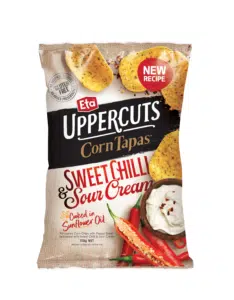
Perfection Packaging aims to provide its customers with packaging that delivers a competitive advantage.
Process control and consistency is the cornerstone of any color management solution, where the aim is for brands to set their color expectations at the digital proof stage.
“Brands want a beautiful pack on shelf at the most cost-effective price.”
For Perfection Packaging, to achieve the same result on press as this digital proof – with minimal make-ready – required standard setup on press plus ink control with highly repeatable, consistent plates, crucial to achieving the proof-to-print match. Bundled into the setup is the selection of the optimal pattern as a foundation.
“With the advanced plate surface patterns, different solids and highlights – for different images – can be achieved on the same plate with the same impression. Controlling the ink flow through the pattern enables this.”
- Before Perfection Packaging started using FLEXCEL NX Plates, the anilox might be varied on each job on the same press.
- Now these variables are fixed, as is required for a color management solution to work. Take a four-color process, with the same print conditions and targets, and the pattern selected for the press and anilox will deliver the same result, every time.
- On every job, there should be a cost versus value assessment. We have found that 133 line screen ruling with the same targeted densities, can achieve an improved print contrast over a 175 line screen, which often needs to be run slower, with more press stops.
- Our plates support screens of 200 line and above. But cost (with slower running and more stops) versus the value doesn’t add up when viewing a 133 line screen package on the supermarket shelf. If anything, the 133 line screen will have more print contrast and more shelf appeal to consumers than a 175 line screen package.
- Achieving these results at 133 line screen helps give brands maximum value.
Narrow web print
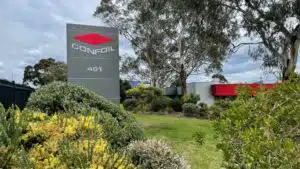
Confoil, a family owned Australian Business since 1966, focused on creating sustainable food packaging solutions.
Confoil, a narrow web printer working with different aniloxes and UV ink, was struggling to achieve the optimal color density with the default FLEXCEL NX Pattern they had originally set up the press with. After running the UV targeted plate surface pattern test and establishing the correct pattern they realized significant savings.
“With the optimal advanced plate surface pattern selected, they were amazed at the consistent and repeatable lift in density and ink release. This enabled process standardization and color management, with proof-to-print matches.”
- Make-ready times fell from over 60 minutes to 20 minutes when we revisit the pattern selection.
- Previously this printer would have made adjustments on press, for example switching to a heavier anilox to improve density, but printing on foil – an expensive substrate – meant putting through large amounts of material to get the print right.
- This reduction in make-ready time dramatically reduced the amount of waste and costs, delivering significant savings.
Clear conversion benefits
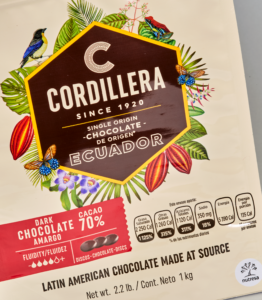
Litoplas S.A., located in Barranquilla, Colombia – delivering unique solutions through design, development, and manufacturing of flexible packaging.
A brand working with converter Litoplas did not believe flexo would produce the detail and color intensity that they required for their luxury product. They wanted to improve their sustainability position by using 7-color EGC process printing to reduce make-ready times and ink waste (no spot colors). This was attempted with other plates.
They identified the following issues:
- poor coverage of the background white
- lower CMYK densities than gravure
- cupping of dots further decreased image vibrance due to “pinholes” in the dots
Using the pattern test across several aniloxes for the white ink, it was identified that one pattern, in combination with an anilox, increased the opacity to be around 59% and without any additional ink usage.
“Testing the process colors, they identified the optimal pattern and as a result, increased the CMYK densities by a minimum of 20%, to be equal to the gravure densities with a smooth laydown. Additionally, the pin holes were eliminated, removing the requirement to increase impression.”
With the correct pattern in use, ECG process printing now produces the vibrancy of color they required, with less ink used and less material waste. This was achieved with faster changeovers and make ready, enabled by the predictability and repeatability of the plates with optimized patterns.
Find Your Pattern
Ask your Miraclon representaive about advanced plate surface patterns and start getting more from your flexo plates to help deliver the beautiful packaging brands are looking for in a cost-effective, efficient print process.
Steve says:
 In this Tech Tip, Steve Smith, Principal Consultant, Advanced Print Applications, explains how the simple, single-color test establishes the pattern you need and shares the productivity gains three printers delivered.
In this Tech Tip, Steve Smith, Principal Consultant, Advanced Print Applications, explains how the simple, single-color test establishes the pattern you need and shares the productivity gains three printers delivered.
“The results of finding your pattern are transformative, ultimately cutting make-ready, reducing ink consumption, minimizing waste and boosting your productivity.”